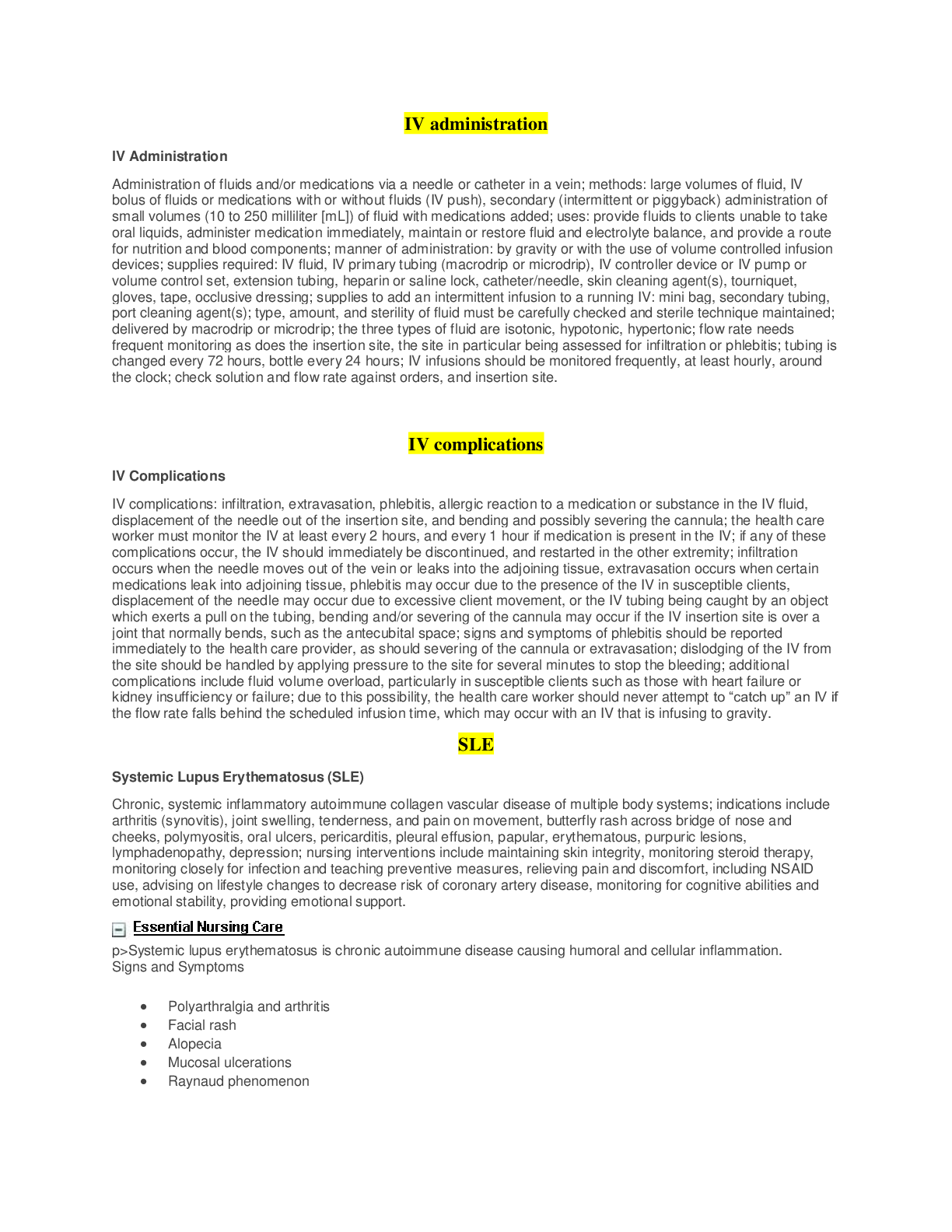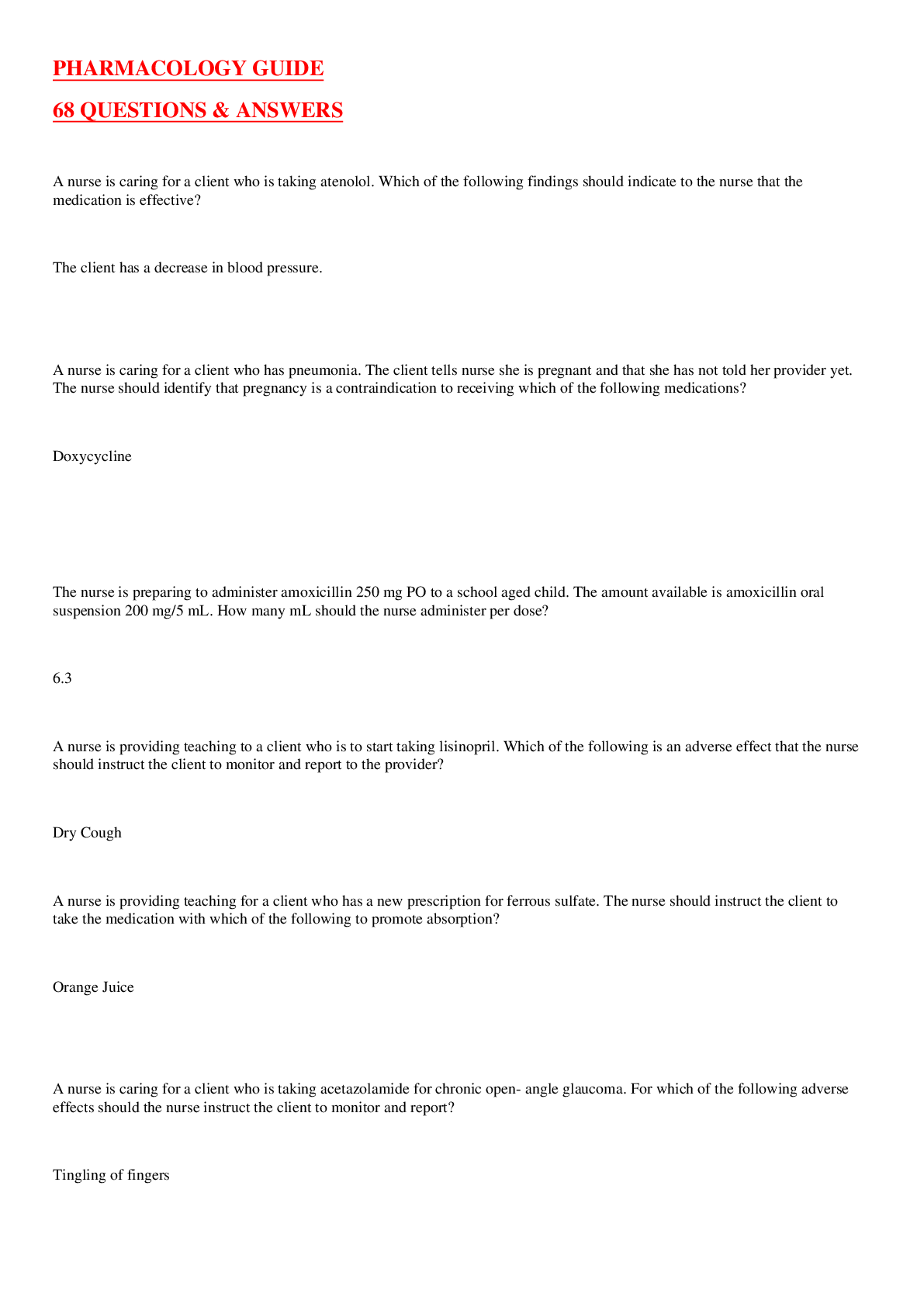English > QUESTIONS & ANSWERS > RVE Study Guide Questions and Answers Latest Updated 2022 Rated A+ (All)
RVE Study Guide Questions and Answers Latest Updated 2022 Rated A+
Document Content and Description Below
RVE Study Guide Questions and Answers Latest Updated 2022 Rated A+ Affix ✔✔A morpheme or meaningful part of a word attached before or after a root or base word to modify its meaning; a category... that includes prefixes and suffixes. Alphabetic Principle ✔✔The use of letters and letter combinations to represent phonemes in an orthography. Automaticity ✔✔Fluent performance without the conscious deployment of attention Base word ✔✔A free morpheme, usually of Anglo-Saxon origin, to which affixes can be added. Blend ✔✔A consonant sequence before or after a vowel within a syllable, such as cl, br, or st; also called "consonant blend." Book talk ✔✔A discussion of one or more books by a teacher, librarian, or student to introduce books and to induce others to read them. Bound morpheme ✔✔A morpheme, usually of Latin origin in English, that cannot stand alone but is used to form a family of words with related meanings. A bound root (such as -fer) has meaning only in combination with a prefix and/or a suffix. Cloze procedure ✔✔Any of several ways of measuring a person's ability to restore omitted portions of an oral or written message by reading its remaining context. Comprehension Monitoring ✔✔The mental act of knowing when one does and does not understand what one is reading.Consonant ✔✔A phoneme that is not a vowel and is formed with obstruction of the flow of air with the teeth, lips, or tongue; also called a closed sound in some instructional programs; English has 40 or more consonants; also may refer to an alphabet letter used in representing any of these sounds. Consonant digraph ✔✔Written letter combination that corresponds to one speech sound but is not represented by either letter alone, such as th or ph. Context ✔✔The sounds, words, or phrases adjacent to a spoken or written language unit. Context clue ✔✔Information from the immediate textual setting that helps identify a word or word group, as by words, phrases, sentences, illustrations, syntax, or typography. Contextual analysis ✔✔The search for the meaning of an unknown word through an examination of its context; the use of a larger linguistic unit to determine the meaning of a smaller unit. Continuant ✔✔Speech sound that can be spoken uninterrupted until the speaker runs out of breath (/m/, /s/, /v/). Decodable text ✔✔Text in which a large proportion of words (approximately 70%-80%) comprise sound-symbol relationships that have already been taught; used to provide practice with specific decoding skills and to form a bridge between learning phonics and applying phonics in independent reading of text. Decoding ✔✔Ability to translate a word from print to speech, usually by employing knowledge of sound-symbol correspondences; also, the act of deciphering a new word by sounding it out. Dialect ✔✔A social or regional variety of a particular language with phonological, grammatical, and lexical patterns that distinguish it from other varieties.ESL students ✔✔Students who are learning English as a second language; Limited English Proficiency (LEP) students. Etymology ✔✔The study of the history and development of the structures and meanings of words; derivation Expressive Vocabulary ✔✔The vocabulary used to communicate in speaking and writing. Figurative Language ✔✔Language enriched by word images and figures of speech. Figure of speech ✔✔The expressive, nonliteral use of language for special effects, usually through images, as in metaphor and personification. Free morpheme ✔✔A morpheme that can stand alone in word formation. Grapheme ✔✔A letter or letter combination that spells a single phoneme; in English, a grapheme may be one, two, three, or four letters, such as e, ei, igh, or eigh. High-frequency word ✔✔A word that appears many more times than most other words in spoken or written language. The best way to learn high-frequency words is through practice with predictable texts. Idiom ✔✔An expression whose meaning may be unrelated to the meaning of its parts. Inflection ✔✔A bound morpheme that combines with base words to indicate tense, number, mood, person, or gender. Intonation ✔✔Pitch level of voice.Invented spelling ✔✔The result of an attempt to spell a word whose spelling is not already known, based on a writer's knowledge of the spelling system and how it works; also referred to as "temporary spelling" or "developmental spelling." KWL ✔✔A strategy developed by Donna Ogle that is especially useful for identifying purposes for reading expository text. The strategy, which typically involves the use of a graphic organizer, prompts the reader to consider What I Know (K), What I Want To Learn (W), and What I Have Learned (L). Language Experience Approach (LEA) ✔✔An approach to language learning in which students' oral compositions are transcribed and used as materials of instruction for reading, writing, speaking, and listening LEP students ✔✔Students with limited English proficiency; students who are learning English as a second language (ESL). Literature circle ✔✔That part of a literature-based reading program in which students meet to discuss books they are reading independently. Note: The books discussed are usually sets of the same title, sets of different titles by one author, or sets of titles with a common theme. Metalinguistic ✔✔Pertaining to an acquired awareness of language structure and function that allows one to reflect on and consciously manipulate the language. Minimal pair ✔✔A pair of words that contrast only in one phoneme. Miscue ✔✔A formal examination of the use of miscues as the basis for determining the strengths and weaknesses in the background experiences and language skills of students as they read. Morpheme ✔✔The smallest meaningful unit of language.Morphology ✔✔The study of meaningful units of language and how they are combined in word formation. Multisyllabic ✔✔Having more than one syllable Narrative text ✔✔Text, usually with the structure of a story, that tells about sequences of fictional or real events and is often contrasted with expository text. Onset ✔✔The part of a syllable before the vowel; some syllables do not have onsets.\n\nExample: "st" in the word stage. Orthography ✔✔A writing system; correct or standardized spelling according to established usage in a given language. Phoneme ✔✔A speech sound that combines with others in a language system to make words Phonemic awareness ✔✔The conscious awareness that words are made up of segments of our own speech that are represented with letters in an alphabetic orthography; also called phoneme awareness. \nA student who possesses phonemic awareness can segment sounds in words and blend strings of isolated sounds together to form recognizable words. Example: separate out the sounds in "bat" Phonetic ✔✔Referring to the nature, production, and transcription of speech sounds. Phonics ✔✔The study of the relationships between letters and the sounds they repr [Show More]
Last updated: 2 years ago
Preview 1 out of 9 pages

Buy this document to get the full access instantly
Instant Download Access after purchase
Buy NowInstant download
We Accept:

Reviews( 0 )
$8.00
Can't find what you want? Try our AI powered Search
Document information
Connected school, study & course
About the document
Uploaded On
Sep 30, 2022
Number of pages
9
Written in
Seller

Reviews Received
Additional information
This document has been written for:
Uploaded
Sep 30, 2022
Downloads
0
Views
107












.png)
.png)
 ans (1).png)
, 100% Correct, Download to Score A.png)

, 100% Correct, Download to Score A.png)
, 100% Correct, Download to Score A.png)






